|
|
Anode Catalyst for the Direct Borohydride Fuel Cell
TIAN Xiao, DUAN Ru-Xia, ZHAO Li-Juan, NAREN Ge-Ri-Le
2017 Vol. 32 (12): 1233–1242
 Abstract
Abstract(
1144 )
 HTML
HTML(
18)
 PDF
PDF(1182KB)(
1253
)
Direct borohydride fuel cell (DBFC) is currently attracted attentions due to its high theoretical cell voltage and power density. However, the anode catalyst of this type of battery is one of the key factors that decide the battery performance. A lot of researches have been done to improve catalytic activity and decrease the cost of the anode catalysts for DBFC in recent years. On the basis of the work principle and anode reaction mechanism of DBFC, the recent progresses of precious metal, transition metal and hydrogen storage alloy as anode catalyst for DBFC are reviewed according to perspective of catalytic performance and types. The existing problems of the anode catalyst is pointed out and the developments of the anode catalyst for DBFC are also proposed.
|
|
|
Operating Temperature on Cathode Material and Electrochemical Performance of Na-NiCl2 Batteries
AO Xin, WU Wei-Xiang, WU Tian, WU Mei-Fen, WEN Zhao-Yin
2017 Vol. 32 (12): 1243–1249
 Abstract
Abstract(
886 )
 HTML
HTML(
10)
 PDF
PDF(1554KB)(
1005
)
Na-NiCl2 battery is an intermediate temperature battery of which the operating temperature is one of the crucial factors for its electrochemical performance and needs to be fully understand. The effects of operating temperature on electrochemical performance of Na-NiCl2 batteries and morphology of the cathode material under different temperatures were studied based on the results of cell test, EIS and SEM measurements. It was found that the reduction of the operating temperature of the Na-NiCl2 battery within a certain range suppressed the growth of nickel particles during cycling and improved the cycle performance of the cell with and without sulfur in the cathode. The surface activity of the nickel particles decreased with reduction of the operating temperature, while the growth rate of nickel particles slow down at low temperature, resulting in improved cell cycle performance of the cell improves. However, much lower operating temperature leads to poor electrochemical performance due to slow electrochemical reaction rate, migration rate of Na+ and poor wettability of sodium on ceramic electrolyte. Based on above tests, the optimum operating temperatures of the cell no matter with or without sulfur are about 260℃.
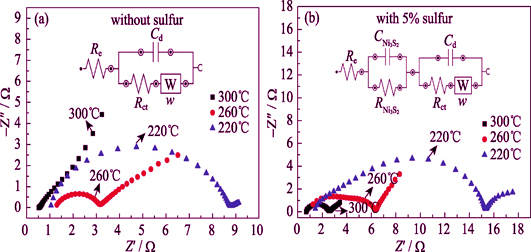
|
|
|
Nickle Electrodes for High-temperature Proton-conducting Electrolytes: Preparation by Electroless Plating and Electrochemical Performance
WEN Ya-Bing, ZHANG Jing-Chao, YE Xiao-Feng, WANG Yong, HAN Jin-Duo, LUO Wen-Hua, GU Sui, MENG Jian-Bo, WEN Zhao-Yin
2017 Vol. 32 (12): 1250–1256
 Abstract
Abstract(
664 )
 HTML
HTML(
9)
 PDF
PDF(1376KB)(
974
)
Nickel layers were deposited on the surface of high-temperature proton-conducting CaZr0.9In0.1O3-δ (CZI) electrolytes by an electroless plating technique. Effects of acid etching and reduction processes on electrode surface morphology and electrolyte adherence to electrodes were investigated by SEM observation. The results showed that the electrodes prepared by a two-step electroless plating process in HNO3-HCl etching solution with hydrazine reducing agent were uniform and well connected to the electrolyte surface. Conductivity and proton transport rate between Ni-CZI symmetric cell and Pt-CZI symmetric cell were compared by electrochemical impedance spectroscopy and concentration cell test. The total conductivity of the Ni-CZI symmetric cell was 4.131×10-4 S/cm at 800℃, and the proton transport rates of the Ni-CZI symmetric cell were all almost 100% at the operating temperature higher than 400℃. The nickel electrode prepared by two-step electroless plating was achievable at low cost and had a comparable catalytic performance to that of platinum electrode, indicating it a promising candidate to replace athe noble platinum catalyst electrode.
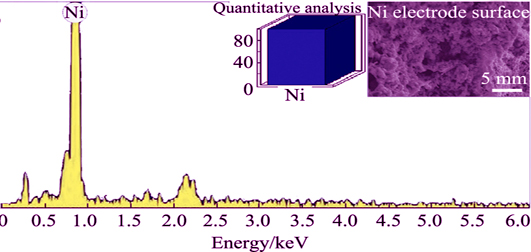
|
|
|
Thermal Reduced Graphene Oxide/Polyimide Nanocomposite Coating: Fabrication and Anticorrosive Property
JIA Ying-Kun, CHEN Pei, ZHANG Qing-Hong, SUN Jing
2017 Vol. 32 (12): 1257–1263
 Abstract
Abstract(
717 )
 HTML
HTML(
8)
 PDF
PDF(756KB)(
1043
)
Thermal reduced graphene oxide (TRGO) was incorporated into polyimide (PI) matrix as two-dimensional nanofillers and TRGO/PI nanocomposite anticorrosive coatings were fabricated. Then AC impedance spectroscopy and dynamic potential polarization curves were adopted to evaluate the electrochemical corrosion behavior of the obtained coatings in simulated seawater (3.5wt% NaCl solution). The results show that the addition of TRGO significantly improves the coating resistance and corrosion protection efficiency compared with pure PI coating. Besides, the TRGO/PI composite coating with the addition of 0.3wt% TRGO shows the most excellent anticorrosive property, with the maximum coating resistance of 1.3176×106 Ω and the highest corrosion protection efficiency of 99.65%. The enhanced anticorrosive property can be attributed to the physical barrier properties of the TRGO with lamellar structure.
|
|
|
Preparation and Property of PDA/CPP Bilayer on SLA Surfaces
ZHANG Jia-Min, WANG Tao, TANG Chun-Bo, WANG Qiao-Na, QIAN Hai-Mei, MIAO Run-Jie
2017 Vol. 32 (12): 1264–1268
 Abstract
Abstract(
740 )
 HTML
HTML(
7)
 PDF
PDF(915KB)(
933
)
A polydopamine/casein phosphopeptides (PDA/CPP) bilayer was prepared on the pure titanium surface with macro and micro pits formed by sandblasting with large-grit and acid-etching (SLA). The PDA interlayer with extraordinary adhesion and the capability of second functional modification, linked CPP, the natural biomolecules, to the SLA titanium surface via covalent bonds. This two-step immersion modification process was simple and feasible. Field emission scanning electronic microscope (FESEM), energy dispersive spectroscope (EDS) and X-ray photoelectron spectroscppe (XPS) were utilized to analyze microtopography and elementary composition of PDA/CPP bilayer. Contact angle analysis, biomimetic mineralization examinations and human bone marrow stem cells (hBMSCs) experiments in vitro were conducted to verify the biocompatibility of the modified surfaces. The results showed that the PDA/CPP bilayer was successfully grafted onto the SLA substrates through the two-step immersion method. The bilayer decreased the contact angle of SLA with pure water from 47.7° to 25.5°, showing the improved hydrophilicity obviously. Compact hydroxyapatite (HA) layer was formed after SLA/PDA/CPP immersed in simulated body fluid (SBF) for 1 d, demonstrating that the bilayer accelerated the rate of biomineralization significantly. Besides, the PDA/CPP bilayer efficiently enhanced the cell attachment, cell proliferation and cell mineralization.
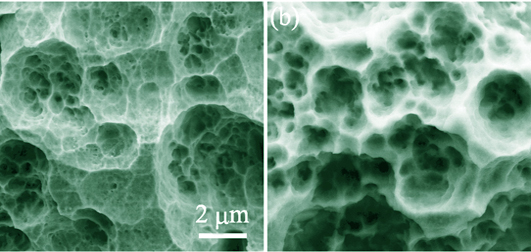
|
|
|
YSZ- Ti3AlC2 Thermal Barrier Coating and Its Self-healing Behavior under High Temperatures
SUN Xu-Xuan, CHEN Hong-Fei, YANG Guang, LIU Bin, GAO Yan-Feng
2017 Vol. 32 (12): 1269–1274
 Abstract
Abstract(
739 )
 HTML
HTML(
16)
 PDF
PDF(982KB)(
1143
)
Ti3AlC2 acting as a new self-healing agent was added into yttria-stabilized zirconia (YSZ) thermal barrier coatings. By atmospheric plasma spraying (APS), thick coatings were prepared using YSZ-Ti3AlC2 mixing powder. To observe oxidation and self-healing behavior, cracks were prefabricated on the surface of YSZ-Ti3AlC2 coating by uniform external load. The prepared samples were then isothermal treated at 1050℃ in air. The phase and morphology evolution of the coatings, as well as the self-healing behavior were investigated via several analyzing methods. The results showed that a part of Ti3AlC2 was decomposed into TiC after spraying and a double layered structure composed of a TiO2 outer layer and a TiO2+Al2O3 inner layer was formed after isothermal treatment. In the process of self-healing, oxidation of the healing agent in the coating led to the growth of alumina and low-density titanium oxide in the cracks. These oxides gradually filled the cracks due to the diffusion-controlled oxidation. Meanwhile, the compressive stress induced by the volume expansion of TiO2 growth in the crack enhanced the healing effect. And eventually the prefabricated cracks were healed.
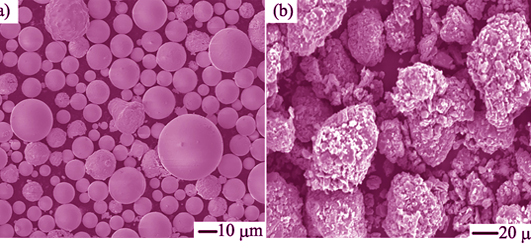
|
|
|
Rare Earth Oxides on Property of Pressureless Sintered Si3N4 Ceramics
DUAN Yu-Sen, ZHANG Jing-Xian, LI Xiao-Guang, HUANG Ming-Ming, SHI Ying, XIE Jian-Jun, JIANG Dong-Liang
2017 Vol. 32 (12): 1275–1279
 Abstract
Abstract(
783 )
 HTML
HTML(
7)
 PDF
PDF(1245KB)(
1362
)
High thermal conductivity Si3N4 ceramic is a prospective substrate material for high-power electronic devices. In this paper, pressureless and liquid-phase sintering was proposed using Re2O3 (Re=Sm, Er, Lu) - TiO2 as sintering additives to effectively reduce the cost for applications. Effect of the additive type and content on microstructure, mechanical properties and thermal conductivity of the ceramic were investigated. Results showed that the relative density, thermal conductivity and grain size of Si3N4 decrease gradually with the increase of Re ionic (Re3+) radius. With addition of Sm2O3, the highest density can only reach 3.14 g/cm3, while the fracture toughness about 5.76 MPa•m1/2 can be obtained when 8wt% Sm2O3-TiO2 is used. With 12wt% Lu2O3-TiO2 as sintering aid, Si3N4 ceramics show high density of 3.28 g/cm3 as well as high fracture toughness, while the thermal conductivity is only 42 W/(m∙K) due to the presence of large amount of second phase. Thermal conductivity of Si3N4 reaches 51.8 W/(m∙K) with the addition of 8wt% Er2O3-TiO2, which can meet the requirement for substrate materials for power electronic device.
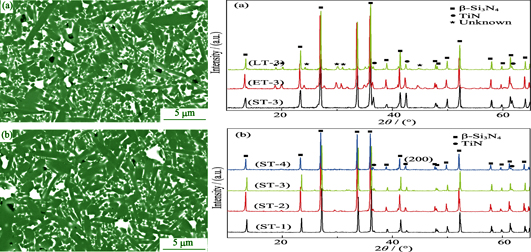
|
|
|
Microstructure, Mechanical and Tribological Property of TiAlN/VN Nano-multilayer Films
LI Miao-Lei, WANG En-Qing, YUE Jian-Ling, HUANG Xiao-Zhong
2017 Vol. 32 (12): 1280–1284
 Abstract
Abstract(
663 )
 HTML
HTML(
2)
 PDF
PDF(1571KB)(
912
)
A series of TiAlN/VN nano-multilayer films were prepared by reactive magnetron sputtering method. The effects of modulation structure on the microstructural evolution, mechanical and tribological properties were investigated by X-ray diffractometer, scanning electron microscope, high-resolution transmission electron microscope, nano- indention device and high vacuum tribometer. The results show that the structure of TiAlN/VN nano-multilayer films with different modulation periods are all typical columnar crystals. Meanwhile, the insertion of the VN sublayers does not interrupt the columnar crystal growth of TiAlN sublayers. In the TiAlN/VN nano-multilayer films, TiAlN sublayers grow coherently and epitaxially over VN sublayers under the critical modulation period. Correspondingly, the hardness and the modulus of the TiAlN/VN nano-multilayer films increase significantly, and the maximum hardness and elastic modulus of TiAlN (10 nm)/VN (10 nm) nano-multilayer films increase by about 39.3% and 40.9% compared with the TiAlN single film, respectively. The strengthening of the TiAlN/VN nano-multilayer films can be attributed to the coherent interfacial structure. In addition, the friction coefficient of TiAlN single film is about 0.9, while that of TiAlN/VN nano-multilayer films can be decreased significantly and reaches a minimum value of ~0.4 by the periodic insertion of the VN sublayers with lower friction coefficient ~0.3.
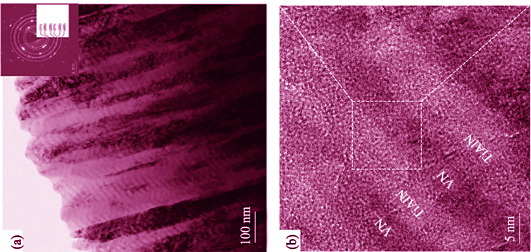
|
|
|
Deposition Mechanism Based on Plasma Spray-Physical Vapor Deposition
DENG Zi-Qian, LIU Min, MAO Jie, ZHANG Xiao-Feng, CHEN Wen-Long, CHEN Zhi-Kun
2017 Vol. 32 (12): 1285–1291
 Abstract
Abstract(
769 )
 HTML
HTML(
4)
 PDF
PDF(868KB)(
953
)
Thermal barrier coatings (TBCs) were prepared via plasma spray-physical vapor deposition (PS-PVD) technique at five spray distances by using agglomerated ZrO2-7wt%Y2O3 (7YSZ) powders. The microstructure and phase composition of these coatings under different spray distances were analyzed by field emission-scanning electron microscope (FE-SEM) and X-ray diffraction (XRD). Besides, gas concentration of the powders in plasma jet was diagnosed with stand-off distances by Optical Emission Spectroscopy (OES). Eventually, three formation mechanisms of the PS-PVD coatings based on vapor deposition were proposed, and the relationship between the concentration of gas phase and the microstructure of the coatings was explained. The results reveal that: (1) the coatings prepared at spray distance of 350 mm and 1800 mm exhibit dense structure, while typical PS-PVD 7YSZ columnar coatings were formed at spraying distance of 650-1250 mm; (2) the coating formed at 350 mm spraying distance is composed of t°- and m-ZrO2, and others are mainly composed of t°-ZrO2 at over 650 mm stand-off distance; (3) At 350 mm spray distance, the coating is developed under the combination effect of the supersaturated spontaneous nucleation from high concentration of the gas phase and liquid/solid particles. At spraying distance of 650-1250 mm, the growth of columnar coatings are dominated by the non-spontaneous nucleation after the deposition of gas phase on the substrate, and supplemented by spontaneous nucleation in plasma jet. At spraying distance of 1800 mm, the coating is accumulated from spontaneous re-solidified gas phase particles.
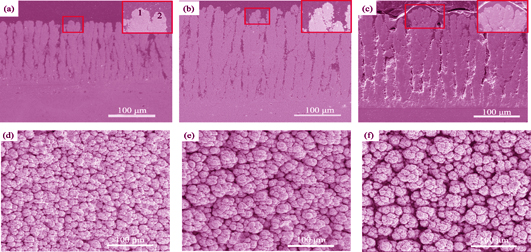
|
|
|
Current Density on Microstructure and Thermal Control Performances of MgO-ZnO Ceramic Coatings
LI Hang, LU Song-Tao, QIN Wei, WU Xiao-Hong
2017 Vol. 32 (12): 1292–1298
 Abstract
Abstract(
599 )
 HTML
HTML(
7)
 PDF
PDF(1307KB)(
1160
)
MgO-ZnO thermal control coatings were prepared on AZ31 magnesium alloy using micro-arc oxidation (MAO) in the electrolyte containing Zn(H2PO4)2. The influence of current density on the microstructure, composition, adhesive strength, and thermal control performances of MAO coatings were investigated, and the variation of solar absorptance (αs) was examined at different ultraviolet irradiation time. The results show that the MAO coating is composed of MgO, ZnO and a few amorphous phases. With an increase of current density, the number of pores gradually decreases while the roughness increases. As the thickness, adhesion and emittance (ε) firstly increase and then decrease, the changing tendency of αs shows the opposite. When the current density is set at 9 A/dm2, the MAO coating exhibits a stronger adhesive strength of 12.6 MPa, a higher ε of 0.872 and a lower αs of 0.363. Moreover, the ultraviolet irradiation test reveals that the αs increases followed by leveling off with increasing irradiation time. This process provides a technical support for fabricating thermal control coating with excellent adhesion, low αs/ε ratio, and good anti-ultraviolet irradiation.
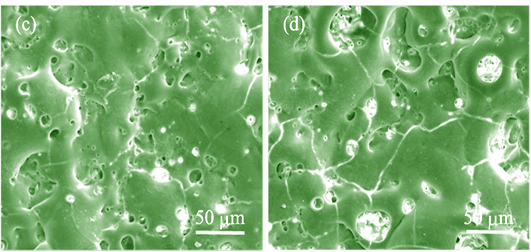
|
|
|
Co Content on Absorption Property of C/Co Nanofibers as a Lightweight Microwave Absorber
ZHANG Xue-Ke, XIANG Jun, WU Zhi-Peng, LIU Min, SHEN Xiang-Qian
2017 Vol. 32 (12): 1299–1307
 Abstract
Abstract(
633 )
 HTML
HTML(
9)
 PDF
PDF(853KB)(
1014
)
C/Co nanofibers (NFs) as a high-performance lightweight microwave absorber in the 2-18 GHz band were fabricated by a facile electrospinning process combined with subsequent heat treatment. The effects of Co content on the electromagnetic characteristics and microwave absorption properties of C/Co NFs were investigated. The microwave absorption performance of C/Co NFs is significantly enhanced as compared to that of pure carbon nanofibers (CNFs) and the primary microwave absorption mechanism is ascribed to the dielectric loss. With increase of Co content, the electromagnetic attenuation capability of C/Co NFs monotonically decreases, while their microwave absorbing ability firstly rises and then drops. The C/Co-5 NFs sample with 37.8wt% Co exhibits the best performance for microwave absorption due to a good impedance matching and sufficiently high electromagnetic attenuation capability, which result from proper combination and synergistic effect between Co particles and CNFs, as well as the particular Co particle@graphite core-shell structure in the NFs. The simulation results show that a reflection loss (RL) exceeding -20 dB is obtained in a wide frequency range of 3.2-18 GHz for the silicone composite contained only 5wt% C/Co-5 NFs by choosing an appropriate layer thickness between 1.1 mm and 5.0 mm, and an optimal RL value of -78.8 dB is obtained at a layer thickness of 2.5 mm. More importantly, when the absorber thickness is as thin as 1.5 mm, the absorption bandwidth (RL≤-20 dB) is up to about 6 GHz ranging from 12 GHz to 18 GHz, which covers the whole Ku-band. The excellent microwave absorption property together with lightweight and ultrathin thickness of C/Co NFs indicate that these magnetic carbon hybrid nanofibers can be used as a novel and promising microwave absorbing material.
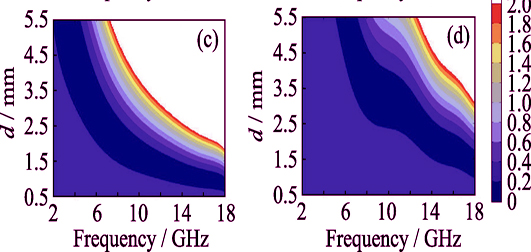
|
|
|
Preparation of MnS with Different Crystal Phases for Photocatalytic H2 Production from H2S
DAN Meng, ZHANG Qian, ZHONG Yun-Qian, ZHOU Ying
2017 Vol. 32 (12): 1308–1314
 Abstract
Abstract(
1045 )
 HTML
HTML(
28)
 PDF
PDF(607KB)(
1310
)
Cubic α-MnS and hexagonal γ-MnS were successfully prepared by a one-pot solvothermal method. X-ray diffraction (XRD), scanning electron microscope (SEM), transmission electron microscope (TEM), high-resolution transmission electron microscopy (HRTEM), selected area electron diffraction (SAED), and UV-Vis absorption spectrum were used to investigate the phase, microstructure, morphology, and optical property of the obtained samples. The photocatalytic H2 production performances from H2S of α-MnS and γ-MnS were evaluated both under visible light (λ > 420 nm) and UV-Vis light irradiation. The results revealed that both α-MnS and γ-MnS possess photo-splitting H2S activity under visible light, and the metastable state γ-MnS showed better photocatalytic H2 evolution performance (23.38 μmol/(g·h)) than the stable form α-MnS (4.24 μmol/(g·h)). Comparing the photocatalytic activity under visible light, it was found that the hydrogen production rate of α, γ-MnS under the full spectrum irradiation increased remarkably. A maximum H2 production rate of 2272.69 μmol/(g·h) was achieved over γ-MnS under the full spectrum irradiation. It is noteworthy that during the process of 6 h photocatalytic testing, α, γ-MnS displayed a good stability and resistance to the photocorrosion. In addition, the catalytic mechanism of α, γ-MnS was investigated. Finally, the reason for the difference in photocatalytic activity between these two MnS phases was explored.
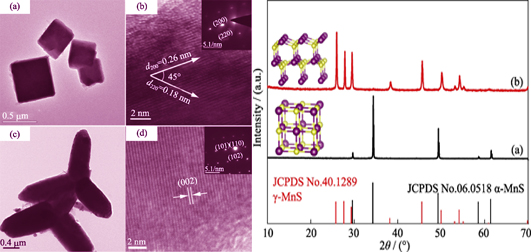
|
|
|
Sintering and Optical Property of Nd3+:Lu2O3 Fabricated by Spark Plasma Sintering
AN Li-Qiong, ZHANG Jian, FAN Run-Hua, GOTO Takashi, WANG Shi-Wei
2017 Vol. 32 (12): 1315–1320
 Abstract
Abstract(
624 )
 HTML
HTML(
3)
 PDF
PDF(1044KB)(
989
)
Lu2O3 is a novel material for high-power solid-state lasers due to its high thermal conductivity. In present work, Nd3+:Lu2O3 transparent ceramics with different Nd3+ doping concentration (CNd = 0, 1at%, 3at% and 5at%) were fabricated by spark plasma sintering, using commercial oxides as raw materials and LiF as sintering aid. The effect of Nd3+ doping concentration on phase, sintering property, microstructure and optical properties was investigated. X-ray powder diffraction (XRD), scanning electron microscopy (SEM), UV-VIS-NIR spectroscopy, and fluorescence spectroscopy were used for characterization. The results show that the sintered body exhibits pure Lu2O3 phase even with high Nd3+ doping concentration (5at%). The Nd3+ doping concentration has little influence on densification behavior and microstructure of Nd3+:Lu2O3 ceramics. All the sintered bodies have a high relative density above 99.5% and excellent transparency, in which 3at% Nd3+:Lu2O3 body shows highest transmittance, with values of 82.7% and 83.2% at 1064 and 2000 nm, respectively. Nd3+:Lu2O3 transparent ceramics show strongest emission bands located at 1076 and 1080 nm, which are attributed to the 4F3/2→ 4I11/2 transition of Nd3+ ions. The emission intensity and decay time decrease with increasing Nd3+ doping concentration, which indicates concentration quenching.
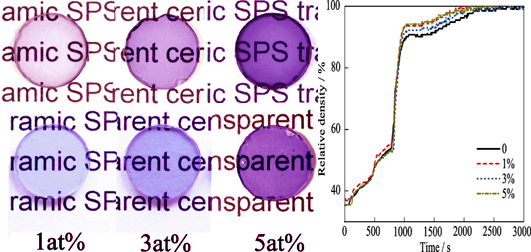
|
|
|
Regrowth of CdTe Quantum Dots Induced by Circular Polarized Light and Its Effect on the Photoluminescence
YAN Bo, PENG Ze-Yang, LV Bin, LIU Wei
2017 Vol. 32 (12): 1321–1326
 Abstract
Abstract(
668 )
 HTML
HTML(
6)
 PDF
PDF(807KB)(
1019
)
The water soluble CdTe quantum dots were synthesized in aqueous solution using 3-mercaptopropionic acid as stabilizer reagent. Effects of non-polarized and circular polarized light modification on structural and optical properties of quantum dots were investigated by photoluminescence spectroscope, ultraviolet visible absorption spectroscope, transmission electron microscope, and X-ray diffraction. It is revealed that the non-polarized light tends to oxidize the quantum dots, which brings about photo degradation of quantum dots and blue shift of photoluminescence. By contrast, the circular polarized light oxidizes the stabilizer reagent at the surface of CdTe quantum dots, which leads to regrowth of quantum dots and red shift of photoluminescence. Moreover, the photochemical reaction mechanism together with the bonding effect between stabilizer reagent and CdTe quantum dot were studied. The photoluminescence of CdTe quantum dot is associated with its surface states.
|
|
|
TiO2 Nanoring/Nanotube Hierarchical Structure Growth Mechanism and Optical Absorption Property
ZHAO Yang-Bo, SANG Li-Xia
2017 Vol. 32 (12): 1327–1331
 Abstract
Abstract(
609 )
 HTML
HTML(
3)
 PDF
PDF(1643KB)(
889
)
On the top of TiO2 nanotube arrays, nanograss structure may be generated due to electrolyte composition, the oxidizing condition and the size of nanotube in anodic oxidation process. TiO2 nanoring/nanotube hierarchical structure with smooth surface was fabricated by two-step anodic oxidation. Growth mechanism and optical absorption properties of the resulting TiO2 nanoring/nanotube hierarchical structure were investigated by controlling oxidation time of the anodic oxidation. The results show that the growth of nanotubes is limited by regular hexagonal nanocaves on the surface of Ti substrate during the second step of anodization resulting in formation of TiO2 nanoring/nanotube hierarchical structure. Meanwhile, the nanorings provide the support of their internal nanotubes to avoid formation of nanograss structure. Absorption spectrum of TiO2 nanoring/nanotube hierarchical structure exhibits oscillating peaks in visible light region, due to the interference between lights reflected from the top of nanorings and the bottom of Ti substrate. Based on the relationship between oscillation peaks shape and film thickness, the maximum optical penetration depth of TiO2 nanoring/nanotube hierarchical structure is estimated to be ~2 μm.
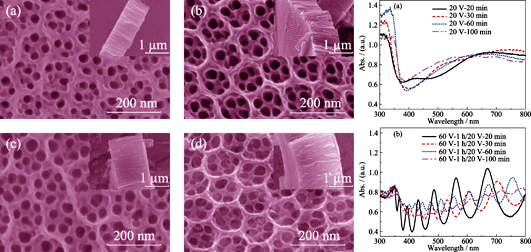
|
|
|
Laser Ablation Behavior of W/ZrC Cermet Fabricated by Displacive Compensation of Porosity (DCP) Method
YU Yi-Ping, WANG Song, LI Wei
2017 Vol. 32 (12): 1332–1336
 Abstract
Abstract(
568 )
 HTML
HTML(
1)
 PDF
PDF(909KB)(
887
)
W/ZrC cermet was successfully fabricated by a Displacive Compensation of Porosity method, and then laser ablation behaviors of W/ZrC cermet under different laser energy and ablation time were studied. Results showed that a small ablation pit was produced on the W/ZrC cermet during the laser ablation, and depth of the ablation pit increased with increasing laser power and prolonging ablation time. Besides, several homocentric loops which had different kinds and microstructures of oxides were formed around the ablation pit. The volatilization of residual Cu and formation of ZrO2 layer played significant roles in protecting W/ZrC cermet from being further oxidized during the laser ablation.
|
|
|
Measuring Ionic Conductivity in Mixed Electron-ionic Conductors Based on the Ion-blocking Method
LIU Yong-Ying, QIU Peng-Fei, CHEN Hong-Yi, CHEN Rui, SHI Xun, CHEN Li-Dong
2017 Vol. 32 (12): 1337–1344
 Abstract
Abstract(
1034 )
 HTML
HTML(
13)
 PDF
PDF(1393KB)(
1232
)
Ionic conductivity is common in liquid-like thermoelectric (TE) materials and it helps to understand the abnormal electrical and thermal transports. However, in experiment, accurately measuring the ionic conductivities in liquid-like TE materials is very difficult because of the very small contribution from ions to the total conductivity. In this study, based on the ion-blocking method proposed by Yokota, a home-made instrument has been built to accurately measure the ionic conductivity of liquid-like TE materials. The basic construction of this instrument and the measurement principles are introduced. The related factors that might influence the measurement accuracy are also analysed. Finally, the ionic conductivities for two typical liquid-like TE materials are presented to show the validity of our home-made instrument.
|
|